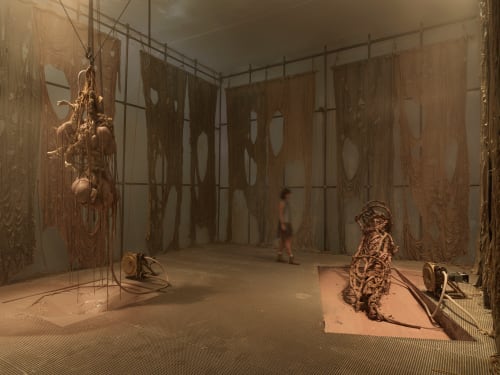Stepping off the elevator to see “Black Sun,” an exhibition of new work by Mire Lee (on view through September 17, 2023), I found myself standing in front of a sheet of tautly stretched translucent plastic, behind which light, moisture, and forms could be perceived. I couldn’t help but think of the movie Seven (1995), with its damp, claustrophobic opening scene (at least as I remember it), and imagined confronting the simulacrum of a crime scene.
The diaphanous surface turns out to be one side of a large rectangular chamber built of metal tubes, with the thin plastic shell forming walls and ceiling. A ramp leading to a short corridor at the center of the shorter end of the rectangle provides access to the room, its interior covered with torn, muddied cloths rent by gaping holes. Hanging from poles on all four sides of the chamber, the dripping fabrics of Black Sun: Surface with many holes (all works 2023) evoke skins, and thus flaying—a theme that recalls another American crime thriller, The Silence of the Lambs (1991). Lee, it is worth noting, is not averse to gore, judging by her earlier work and various statements she has made, and references to film seem justified by the video that fills the wall at the end of a corridor, which one passes before entering Lee’s environment. Made in collaboration with Sophie Soobramanien, Black Sun: Holes and other horizontal forms consists of a sequence of choppy, blurry, and at times ambiguous imagery.
The skins displayed inside the chamber could be imagined as having been torn off one or more bodies, such as Black Sun: Vertical sculpture and Black Sun: Horizontal sculpture, which allude elliptically to a standing and a reclining figure. The first mixed-media accretion consists of bladder-, intestine-, and sinew-shaped forms suspended from the ceiling; with liquid periodically gushing on to their surfaces, they evoke innards strung up in a slaughterhouse or torture chamber. The prone carcass in the second work is made to rotate around its axis by a motor, like a troubled sleeper whose nightmare we have entered. Black Sun: Asshole sculpture, shaped like a low and wide bowl, confirms these anatomical interpretations, suggesting that the mud that covers the sculptures and the floor (a raised grate prevents viewers from slipping) may stand in for other viscous substances.
According to Genesis, dust is the matter out of which God created the first man, and according to the Quran, it is mud. The amount of flesh and bone metaphorically displayed here recalls Carolee Schneemann’s Meat Joy (1964), a (filmed) classic of performance art, as well as the mystical rituals and sacrifices directed by the Vienna Actionist Hermann Nitsch. Lee’s process-emphatic work has a performative aspect, underscored by her sculptures activated by rusting engines, which progressively wear down that to which they give a semblance of life. Lee’s interest in carnage, eroticism, the abject, and intuitive creative interventions is in line with Surrealist practice; while her biomorphic forms, sinuous lines, and painterliness—with the flinging around of grease, glycerin, silicon, oil, and clay slip—constitute a response to Abstract Expressionism. Meanwhile her parallels between bodies and machines go back to Marinetti, Duchamp, Picabia, Léger, Malevich, and, of course, film. Like the kinetic sculptor Jean Tinguely, the movie directors Fritz Lang and Charlie Chaplin, and many others, Lee has a bleak outlook on industrial revolution: it leaves carnage and a landscape of despair in its wake.
Her skins also bring up ancient myth (Apollo and Marsyas—don’t challenge the gods) and Christianity (the martyrdom of Bartholomew—die for your beliefs). The bowl-shaped anus—at the opposite end of the mouth—alludes to the end. Lee’s charnel house could have been ideated by the Marquis de Sade. The screwing motion of the carcass enacts a term referring to fornication, as well as our contemporary plight. “Black Sun,” we are told in the press release, is named after “a study of depression and melancholia by the Bulgarian-French feminist and philosopher Julia Kristeva.” To me, that title conjures the end of Enlightenment hopes—all that expended energy, and what we end up with is mud. Ashes to ashes, dust to dust. Mud rhymes with blood.
—Michaël Amy


